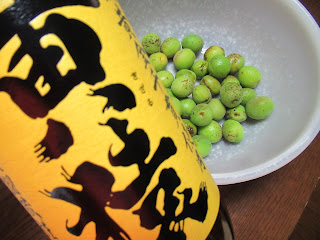In Japan, the most traditional way to deal with Ume plums (Prunus mume) is making Ume pickles, aka Umeboshi. It’s a sort of life-long mission to establish “one and only” kind of recipe for Umeboshi … There are several nonagenarians (such as she, or she) who are still honing today their 70+ years of Ume pickle making career. Naomi is a sort of new-born baby in front of these incredible seniors … But, actually, the recipe for making pickles is simple. The real crux of the matter lies in somewhere else, like the condition of fruits, weather, climate, or mental condition of the pickler … Anyway, this week and the next are for my recipe of making Umeboshi.
 |
| Washed and prepared Ume
fruits. Yeah, they are still green but not so much. It’s OK to use this level of ripening. Could you see their skin does not have punctuation? |
Second, sprinkle distilled strong alcohol, like vodka or gin, over the fruits and gently smear the liquid to the entire Ume by hand. At the same time, sprinkle the same alcohol to the sanitized pickling container. It’s to make it easy for salt to be attached to the whole fruits. Next, weigh salt for pickling. Once it was standard to use salt in the amount of 20% of weight of Ume fruits for Umeboshi. So, if the entire Ume plums prepared was 1Kg, the salt to be used was 200g. When we consider health problems of too much salt, this recipe was … er, risky. So, these days standard recipe for Umeboshi recommends 15-18%, or even 12%, of weight for fruits. But, I tell you, for novices, reducing the amount of salt is tricky. Especially for hot and humid Japanese summer, insufficient amount of salt will make the pickles rotting quickly. After many tears dropped, I’ve settled at 18%.
 |
| Alcohol-smeared fruits. I used Shochu, distilled Japanese beverage. |
Leave 1/3 of salt for the final coating and sprinkle enough salt from the rest over the bottom of pickling container. Gently place liquor-coated Ume fruit one-by-one to cover the entire base of the container. When the bottom becomes invisible due to the fruits, scatter the salt over the fruits and make the second layer. Repeat this until the entire fruits are neatly stored in the container. Cover the top layer with the saved 1/3 of salt.
 |
| The bottom of the pickling container |
 |
| The top layer with 1/3 of salt over it. |
Seal the salted Ume fruits with plastic wrap. Avoiding the exposure to outside air is the best for the pickles not getting moldy. Considering the problem with plastics, there would be better way to seal Ume pickles … I still cannot find it. So sorry. Next, put on sanitized weight over the salted and covered Ume fruits. Ideally, the load is 2 to 3 times heavier than the fruits. If you use 1Kg of fruits, the weight would be 2-3kg. We can use lighter weight, as sometimes the container cannot have that large mass. I’ve found the lighter the weight, the longer it takes for the fruits to reach to the final process. If you want to make pretty pickles, I recommend to follow “2 to 3 times heavier” standard.
 |
| After sealing the pickles with
plastic wrap, I place a small plate to hold weights without crushing the fruits. |
 |
| My weights. They are rocks of Tanzawa 丹沢 harvested from Yadoriki Water Source Forest やどりき水源林. 😊 |
Clean the inside wall of the container with sanitized cheese cloths or paper towel. Cover the container tightly and leave it in a cool and dark corner of your home. Check daily the condition of the pickles. In about a week or so, clear liquid will ooze out. It’s the sign pickling goes OK. If you cannot find the liquid after 7 days, your weight is too light. Better considering more load over the fruits. The fluid is white Ume plum vinegar, salty but very useful ingredients for our daily cooking. Just leave them as such for 2 to 3 weeks more. If the contents start getting moldy, gently remove and discard the molded part (fruits and vinegar), spray strong distilled alcohol to the remaining pickles, and clean the inside wall of the container with paper towel dampened by vodka or gin.
 |
| My pickling jar. Originally, this container was for making miso paste. The mouth of the jar is a bit small for Umeboshi making. Now I’m searching for a better container in a reasonable price range … |
In Japanese supermarket, 2-3 weeks later from yellow Ume plum fruits appeared for sale, red shiso (perilla) comes. It’s the sign we should start second stage for Ume pickling. I’ll tell you how next week. Please stay tuned. 😉
Office for the Park Greeneries in the North
北部公園緑地事務所
Yokohama Municipal Government Creative Environment Policy Bureau
横浜市環境創造局
Phone: 045-311-2016
FAX: 045-316-8420



No comments:
Post a Comment